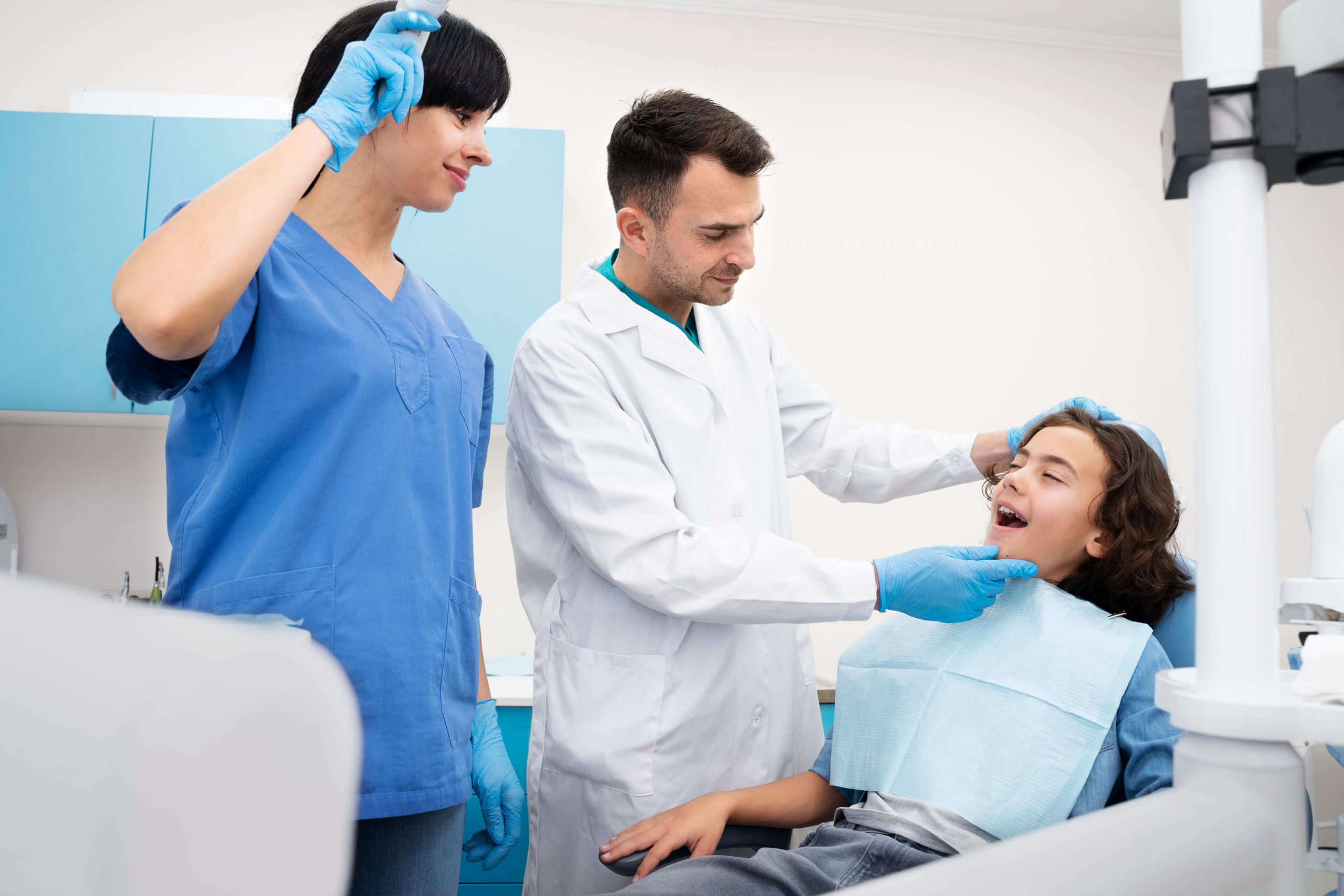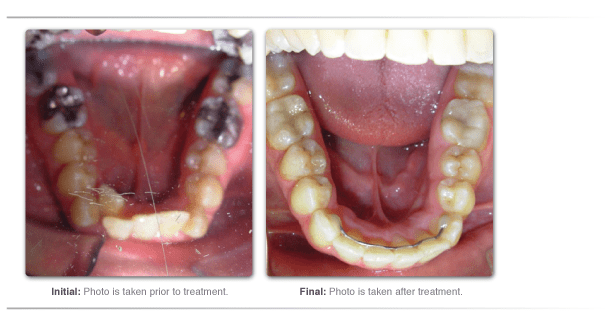
What Can a Dentist Do for Sleep Apnea?
Dentists are in a unique position to diagnose and treat sleep apnea. While dentists cannot technically diagnose sleep apnea as sleep doctors do. Sleep apnea dentists do look in a lot of mouths and airways and the writing is on the wall. Or should I say, in the mouth. Novel dental orthopedic treatments capable of stimulating airway growth (even in adults) are available. The sleep apnea dental treatments permanently enlarge the airway and can cure some sleep apnea conditions.
One treatment offered by Dr. Adams is DNA appliance therapy. The DNA sleep apnea dental treatment results in a larger upper airway at the end of a treatment that lasts 6 – 18 months. Very few dentists offer this treatment yet due to the complexity of treatment. In the US fewer than 1% of dentists are certified DNA appliance providers. Hopefully more dentists will be trained as the demand for sleep apnea dental treatment increases.
Sleep apnea causes, risk and diagnosis
Deep, relaxed and adequate sleep, like adequate nutrition and adequate exercise, is essential for maintenance of healthy human body. Inadequate, disturbed and interrupted sleeping hours produce daytime sleepiness, tiredness and lethargy which will deteriorate general body health with the passage of time. inadequate breathing during sleep can be due to stress, anxiety, nocturnal teeth clenching, respiratory effort related sleep arousals or sleep-induced collapse of the upper airway passages. Your dental health care professional can help you in diagnosing the exact cause of your insomnia and breathing difficulties during sleeping.
What is getting in the way of your airway or causing “obstruction?”
Small mouth or a large tongue? What came first the chicken or the egg? When jaw a facial development is not sufficiently large, we see crowding of the tongue and teeth. In the picture to the right, you can see crowded teeth and tongue spaces. Unfortunately in the “after” picture, there is still crowding of the tongue. This tongue is in a posterior position and will certainly end up in the airway at night.
Extra soft tissue in the throat gets i the way of the airway. including the uvula, tonsils, adenoids and extra posterior palatal tissue. You can also notice the squished posterior position of the tongue. In this picture the tongue is further back in the mouth and literally on top of the airway. No surprise that all this stuff can get in the way of night time breathing. Who is in a better position to notice this stuff better than a well trained sleep apnea dentist?

small airway dentist 12

What is sleep apnea? Is it related to snoring during sleep hours?
Repetitive and routine blockage of airway passages during sleeping may result in breathing cessation or interruptions at night. This obstruction of the normal breathing pattern limits the amount of much needed fresh air replenishing the lungs. Airway blockage results in the production of loudly audible snoring and choking sounds. Snoring sounds are usually considered normal and people do not even consult their family physicians or dentists in this regard unless problems in normal breathing are detected.
Most of the population does not even know about this snoring habit until their spouses or roommates feel disturbed and mention it at last. Frequent and loud snoring noises can be an indication and symptom of a frequent and potentially dangerous breathing illness known as sleep apnea. During sleep apnea, normal breathing activity stops and then re-starts again. The whole repetitive process involuntarily continues for hours at night during sleeping. Snoring may not occur in conjunction with sleep apnea state in many individuals and this further makes sleep apnea diagnosis difficult. Breathing is interrupted continuously and becomes shallow during sleep. 10-20 second duration pauses are usually recorded between normal breathing with a frequency of more than 100 times adversely affecting the sleep cycle.
What is the prevalence of sleep apnea?
The overall prevalence of sleep apnea is high and still progressively growing. 20-40 million individuals in the U.S. are suffering from this dangerous breathing problem and the alarming aspect is that approximately 90% of the patients remain undiagnosed for many years.
What are the various causes and common risk factors associated with sleep apnea?
- Overweight and obese individuals are always at higher risk for sleep apnea occurrence. Obesity can cause the tongue to fall back and block air passages hampering the normal flow of air towards lungs,
- Males are at higher risk as compared to females,
- Genetic predisposition has been observed in sleep apnea. If one family member has developed sleep apnea, others should consult their dentist and family physician for early diagnosis and management,
- Old age i.e. above 60 years is an important risk factor for sleep apnea,
- Small-sized, deformed and abnormally developed thin airways in the nose, mouth and throat area,
- Tobacco Smoking increases the chances for sleep apnea occurrence,
- Strong evidence for racial predilection,
- Inflamed or enlarged tonsils in tonsillitis in children are risk factor for sleep apnea,
- Thick neck tissues,
- Unhealthy and unhygienic lifestyle,
- Excessive consumption of alcohol,
- Misuse of sedatives and hypnotic drugs,
- Nasal septum deviation can cause blockage of pharyngeal airways during sleep.
What are the different types of sleep apnea?
Sleep Apnea Can Be Classified Into 3 Different Types
- Obstructive sleep apnea is the most commonly occurring type characterized by loud snoring sounds.
- Central sleep apnea occurs less frequently as compared to obstructive type. Snoring occurs rarely in this condition.
- Complex sleep apnea is characterized by intermediate features of the above two types.
What are the different signs and symptoms which point towards the development of sleep apnea?
Clinical features which can be seen in sleep apnea patients are,
- Loud snoring sounds can be heard especially in obstructive sleep apnea,
- Daytime sleepiness and dizziness occurs irrespective of long stay in bed during night,
- Laziness and lethargic attitude,
- Loss of concentration and focus at work is common in affected individuals,
- Long pauses during normal breathing,
- Cessation of breathing may occur,
- TMJ pain. Tooth clenching is reported by nearly 80% of people with OSA
- Severe headache especially during morning time after waking up from sleep,
- Increased tension, stress and anxiety is common,
- Night time teeth grinding and clenching,
- Dryness of mouth (xerostomia) is common,
- Head, neck and throat infections occur often,
- Increased episodes of nocturnal urination,
- Disturbances in normal growth and development in infants and small children,
- Mouth breathing habit due to breathing difficulties,
- Tooth surface loss or worn teeth,
- Cracked and fractured tooth portions,
- Pain and discomfort on chewing and biting
- Missing teeth, dental implants and root canals
What are the risks or adverse consequences associated with sleep apnea?
These can be,
- Alarmingly Slowed down or reduced reflexes,
- Daytime dizziness,
- An urge to sleep during daytime,
- Loss of concentration during work,
- Loss of focus during studies,
- Increased occurrence of road side traffic accidents (RTAs),
- Increased occurrence of health issues such as development of diabetes mellitus, blood pressure disturbances, brain illness and heart disorders,
- Increased weight gain,
- Drowsiness and lethargy,
- Inability to remember events (Memory loss),
- 3-5 times increased risk for accidents,
- Greatly reduced productivity in life,
- Increased risk of fatal diseases (Myocardial infarction, CHF, CVA)
- 3 to 2.5 times more chances of hypertension,
- 2 times increased risk of nocturnal cardiac arrhythmia,
- 9 times more likely to have congestive heart failure,
- 6 times increased chance of cerebro-vascular stroke,
- 4 to 2.3 times greater risk of myocardial infarction,
- 40% increased risk of depression and anxiety.
What are the various methods for diagnosis sleep apnea?
Early screening is of vital importance. Diagnosis can be done through,
- Complete patient history,
- Spouse history for snoring,
- Comprehensive clinical examination,
- Thorough dental check up,
- TMJ examination,
- Psychiatric evaluation,
- In-laboratory polysomnography,
- At-home polysomnography,
- An FDA-approved limited channel ambulatory testing device which ensures chain of custody.
What is proper management of sleep apnea?
Sleep apnea can be managed with good outcomes and people can get their life back to normal in quick time. Patient compliance and cooperation is necessary for successful management. Different medical treatment options and special dental devices fabricated to treat this disease are helpful. Different interventions are,
- Positional therapy focusing upon sleeping on your side,
- Avoidance of lying down on the back during sleeping,
- Sewing a tennis ball on the back side of the shirt or trouser’s top pocket is helpful,
- Weight loss is important,
- Use of a specially designed cervical pillow,
- Elevation of bed head for a few inches to provide ease,
- Maintenance of a sleep diary for recording sleep interruptions and awakening episodes during night,
- Use a nasal dilator,
- Get treatment of any systemic heart or brain disease causing/associated with sleep apnea,
- Maintenance of continuous positive airway pressure (CPAP) is very helpful in treating sleep apnea. CPAP is generally maintained by a mask-like device which provides streamlined air flow for keeping breathing passageways open and dilated.
- CPAP devices without mask for nasal hood phobic people,
- Some oral and dental appliances can also help.

 (301) 421 1996
(301) 421 1996 burtonsvillesmiles@gmail.com
burtonsvillesmiles@gmail.com